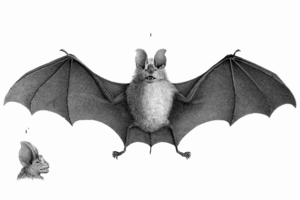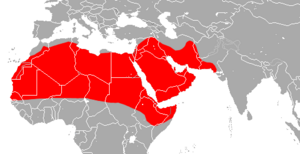Trident bat facts for kids
Quick facts for kids Trident bat |
|
|---|---|
 |
|
| Conservation status | |
| Scientific classification | |
| Genus: |
Asellia
|
| Species: |
tridens
|
 |
|
| Trident bat range | |
The trident bat (Asellia tridens) is a type of bat. It's also called the trident leaf-nosed bat because of its unique nose shape. These bats live in many places, including the Middle East, parts of Asia, and Africa. You can find them in warm, dry areas like dry forests, savannas, shrublands, and even hot deserts and caves. They belong to the Hipposideridae family of bats.
Contents
What Does the Trident Bat Look Like?
Trident bats are quite small. They usually weigh about 12–13 g (0.42–0.46 oz), which is like a few quarters. Their forearms are around 50 mm (2.0 in) long.
The Trident Bat's Life Cycle
Female trident bats are pregnant for about 10 weeks. They give birth to their babies, called pups, in late June and early July. Each mother usually has one pup at a time.
When a pup is born, it's quite big compared to its mother. It can weigh up to 30% of its mother's weight, which is about 2.5–3 g (0.088–0.106 oz). Pups are born without hair and with their eyes closed. This means they are altricial, needing a lot of care from their parents.
However, their eyes open quickly, usually within three or four days. Their fur also starts to grow around this time. For the first few days, the pup stays attached to its mother. After three or four days, mothers leave their pups safely in the roost at night. This allows the mothers to go out and find food.
Pups learn to fly when they are about three weeks old. They become fully independent and stop drinking their mother's milk by six or seven weeks old.
Who Hunts the Trident Bat?
Trident bats can be hunted by different birds of prey. These include birds like the sooty falcon, lanner falcon, barn owl, Pharaoh eagle-owl, spotted eagle-owl, and Long-eared owl.
Protecting the Trident Bat
As of 2017, the trident bat is considered a least-concern species by the IUCN. This means they are not currently in danger of disappearing. They are found over a large area, and there are many of them. Their numbers are not dropping quickly. Many trident bats also live in protected areas, which helps keep them safe.


